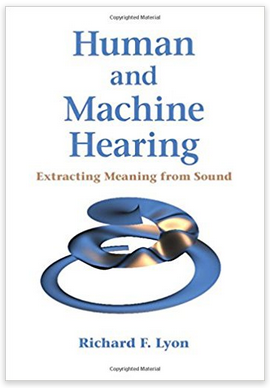
Technical web site for Dick Lyon — "Richard F. Lyon" <dicklyon@acm.org>
New: "Kindle Companion" free PDF – all the figures and boxes in one high-res file (55.5 MB), including color images.

I don't have copies of all my 70 issued US patents on-line, but can provide them on request. Here's a PDF file of all their front pages.
The only things so far here are some of my tech papers from recent years, and a few older ones. Co-authors and other details are noted in the PDFs. If you need more citation details, ask me, or for most cases look it up at IEEE Xplore or CiteSeer.IST
* Cascades of two-pole–two-zero asymmetric resonators are good models of peripheral auditory function. J. Acoust. Soc. Am. Volume 130, Issue 6, pp. 3893-3904 (2011). Richard F. Lyon
Abstract: A cascade of two-pole–two-zero filter stages is a good model of the auditory periphery in two distinct ways. First, in the form of the pole–zero filter cascade, it acts as an auditory filter model that provides an excellent fit to data on human detection of tones in masking noise, with fewer fitting parameters than previously reported filter models such as the roex and gammachirp models. Second, when extended to the form of the cascade of asymmetric resonators with fast-acting compression, it serves as an efficient front-end filterbank for machine-hearing applications, including dynamic nonlinear effects such as fast wide-dynamic-range compression. In their underlying linear approximations, these filters are described by their poles and zeros, that is, by rational transfer functions, which makes them simple to implement in analog or digital domains. Other advantages in these models derive from the close connection of the filter-cascade architecture to wave propagation in the cochlea. These models also reflect the automatic-gain-control function of the auditory system and can maintain approximately constant impulse-response zero-crossing times as the level-dependent parameters change. Copyright (2011) Acoustical Society of America. This article may be downloaded for personal use only. Any other use requires prior permission of the author and the Acoustical Society of America. The article appeared in J. Acoust. Soc. Am. vol. 130 and may be found via http://asadl.org/jasa/resource/1/jasman/v130/i6/p3893_s1.
* 2004 ACM QUEUE Magazine, special issue on DSP, guest editorial: DSP 4 YOU
* Pixels and Me, video of my talk at the Computer History Museum
* 2006 SPIE invited paper: A Brief History of 'Pixel'
* Slides for ICIP plenary talk "History and Future of Electronic Color Photography"
* Handout for photography class lecture, shorter version of above ICIP talk
* Color Imaging Conference 2004 — Eyeing the Camera: Into the Next Century
* Draft paper — Depth of Field Outside the Box
* PICS 2000 — Prism-based Color Separation for Professional Digital Photography
* Apple Tech Report 1993 — Phong Shading Simplification
* Trans.ASSP 1988, a "Best Paper" award winner — An Analog Electronic Cochlea
* DARPA 91 meeting — Analog Implementations of Auditory Models
* Custom IC Conf 93 — Cost, Power, and Parallelism in Speech Signal Processing
* Draft paper circa 1994 — Analog VLSI Hearing Systems
* ASIC Conference and Exhibit 1991 — MicroSystems Education and a "Silicon Encyclopedia" Project
* History and Future of Auditory Filter Models with Katsiamis and Drakakis, IEEE Intl. Symposium on Circuits and Systems, ISCAS 2010
* Video of my October 2007 talk at the Berkeley Ear Club, "Cochlear Modeling Retrospective"
* Practical Gammatone-Like Filters for Auditory Processing with Drakakis and Katsiamis, EURASIP Journal on Audio, Speech, and Music Processing, 2007
* Introducing the Differentiated All-Pole and One-Zero Gammatone Filter Responses and their Analog VLSI Log-domain Implementation with Drakakis and Katsiamis, 2006 Midwest Circuits and Systems
* Neuromorphic Systems Engineering 1998 — Filter Cascades as Models of the Cochlea
* Diversity in Auditory Mechanics 1997 — All-Pole Models of Auditory Filtering
* ICASSP 96 tutorial segment — Auditory Effects for ASR
* 1996 draft: The All-Pole Gammatone Filter and Auditory Models
* ICASSP 1994 — Auditory Model Inversion for Sound Separation
* Mechanics and Biophysics of Hearing 1990 — Automatic Gain Control in Cochlear Mechanics
* VLSI 1991 — A Bidirectional Analog VLSI Cochlear Model
* ICASSP 1990 — A Perceptual Pitch Detector
* Caltech tech report 1988 — Cochlear Hydrodynamics Demystified
* Chapter in Visual Representations of Speech Signals 1992 — On the Importance of Time
* ICASSP 1987 — Experiments in Isolated Digit Recognition with a Cochlear Model
* A Signal Processing Model of Hearing — 1978 unpublished
* Micro-Neuro 1996 — On-Line Hand-Printing Recognition with Neural Networks
* NIPS 1996 — Effective Training of a Neural Network Character Classifier for Word Recognition
* Xerox PARC blue-book report 1981 — The Optical Mouse
and an Architectural Methodology for Smart Digital Sensors
(the first PARC blue-book report to be printed in color)
* VLSI Design magazine 1982 — Designing and Testing the Optical Mouse
(with Martin Haeberli)
* Dating the Otis King: An Alternative Theory Developed Through Use of the Internet
(my only article in the Journal of the Oughtred Society, 1998)
* My Otis King's Patent Calculator site (since 1997)
* SouthCon 1981 — Simplified Design Rules for VLSI Layouts
* ICASSP82 — A Computational Model of Filtering, Detection, and Compression in the Cochlea
* ICASSP83 — A Computational Model of Binaural Localization and Separation
* ICASSP84 — Computational Models of Neural Auditory Processing
* ICASSP86 — Experiments with a Computational Model of the Cochlear (Lyon and Dyer)
* ICASSP87 — Speech Recognition in Scale Space
* ICASSP88 — A CMOS VLSI Cochlea
* Signals, Systems and Computers 1990 — Correlograms and the Separation of Sounds
* Signals, Systems and Computers 1991 — CCD Correlators for Auditory Models
* More to come ...